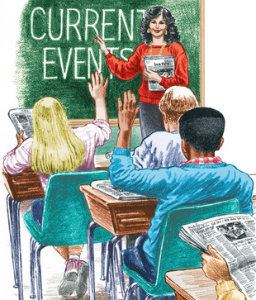Let Your Students Curate Current Events Articles
A MiddleWeb Blog
 One of my favorite activities to help students understand the richness of the news is also one of the simplest.
One of my favorite activities to help students understand the richness of the news is also one of the simplest.
I often do it at the beginning of the year, but you could do it anytime you wanted students to think more deeply about the news stories they are hearing, watching or reading.
For homework one day, I ask students to bring in an annotated current events article. (They don’t have to annotate more than two pages if the piece is longer than that.)
At the beginning of class, they talk in pairs about the pieces they’ve chosen. Together, they categorize their articles as super, okay, or not great to discuss in class. (In some years, I’ve reframed the categories as just important, just interesting, or interesting and important.)
Then they write each of their headlines on the board in the appropriate category, with their names underneath so I can call on them to explain their reasoning. (I make sure to have plenty of white board markers available on days like this!)
As a class, we then discuss a number of the headlines, and I ask students to write down the qualities the headlines had that landed them in each category.
Watching students in action
Below I’ve sorted out the categories and accompanying headlines from this activity in September 2015. I chose a representative day for our current events discussions in terms of the range and variety of current events topics.

For “SUPER to discuss in class” – a description which students often consider a high bar for articles to meet – headlines from 2015 included:
- “Joe Biden, in Colbert Interview, Expresses Doubts about Bid for President”
- “Obama Directs Administration to Accept 10,000 Syrian Refugees”
- “Homo Naledi, New Species in Human Lineage, Is Found in South Africa”
- “Apple Unveils iPhone 6s”
I wrote the following notes on the board based on student comments about why these pieces were “super” to discuss:
♦ Intriguing politics
♦ Human history and ritual
♦ International politics and problems
♦ Weapons of mass destruction
♦ New technology that’s special
The category of “MEDIUM-OKAY to discuss in class” is often the most interesting, because so many stories could go either way. Here are a handful from that day:
- “Court Revokes Approval of Insecticide, Citing Alarming Decline of Bees”
- “No Surf, But Maybe Dunes in NASA’s Latest Pluto Photos”
- “A New 9/11 Memorial to Flight 93”
- “New California Tests Present Sobering Picture of Student Achievement”
This category brought the most discussion, because some fellow students saw these headlines as more important than did their classmates who brought them in! We focused mostly on the quality of discussion that would result from these stories, not how important they were in and of themselves. Thus, some reasons for calling these stories simply “okay” to discuss as a class included:
♦ Almost too sad
♦ Not that important to politics
♦ Not that important to how we live
♦ Important to California but not the U.S.

- “A Monster El Nino Is Likely, But There Are ‘No Guarantees’”
- “Anxiety Builds in Phoenix After Another Mysterious Highway Shooting”
Some students considered the first headline too “uncertain” to delve into very much. For the second, I emphasized that it involved “random violence,” a genre I encourage students to avoid unless the violence is part of a larger pattern that will help us understand society better.
No more cupcake bingeing
In the years before I started doing this one-day activity, I frequently found myself slightly cringing at some fun but ultimately not very meaningful articles that students brought into class for weekly current events homework.
I already prohibited sports and entertainment stories – I’ve always told students that I know they will follow these topics anyway if they find them interesting.

It’s a good set-up for the year
Since I began embedding this sorting-and-grading activity into the early weeks of the school year, I’ve seen students put much more thought into choosing articles for their quarterly presentations and even for the weekly pieces they bring in to talk about informally with me and their classmates.
They are so engaged, in fact, that they feel if a piece does not provoke enough discussion, they have somehow failed. They want to pick something really interesting and important. They curate the pieces as thoughtfully as I would – sometimes even more so – and it’s truly a pleasure to watch!
Feature image: Camera Eye Photography





































